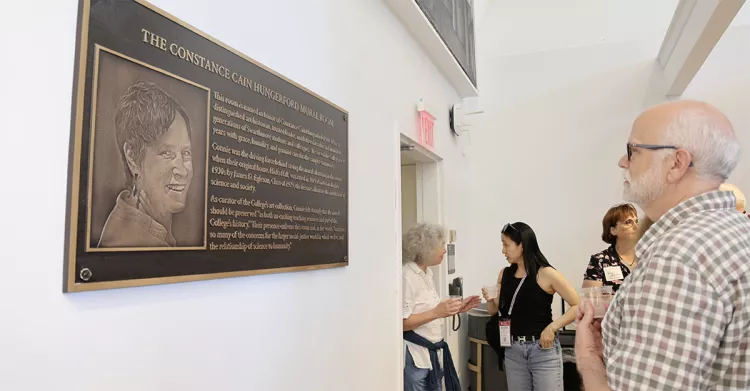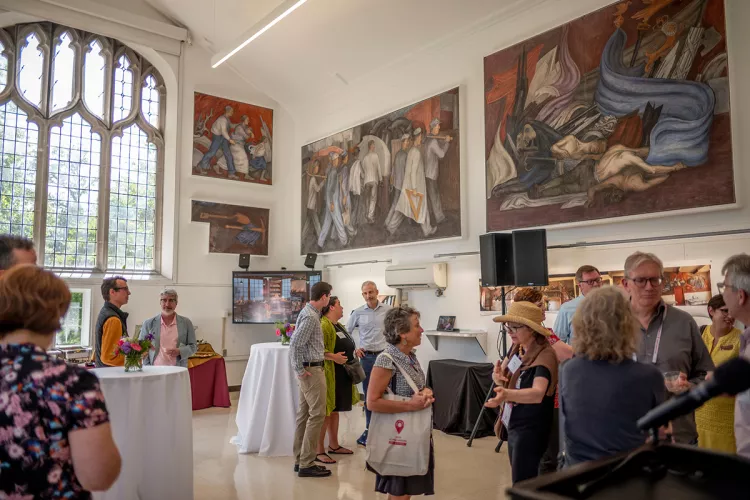Old Tarble Mural Room Dedicated in Memory of Constance Cain Hungerford

On Friday, May 26 during Alumni Weekend, the College dedicated the Constance Cain Hungerford Mural Room in Old Tarble in honor of Mari S. Michener Professor Emerita of Art History and Provost Emerita Constance Cain Hungerford, celebrating her impact on the Swarthmore community and debuting a plaque with her likeness in the studio.
Widely respected scholar, inspiring teacher, trusted role model, and confidante, Hungerford, known by all as Connie, died on May 12, 2021, at age 73. She served the College confidently as provost from 2001 to 2011 and interim president from 2014 to 2015.
Along with her other duties, she served as the curator of the College’s art collection. Notably, Hungerford helped facilitate the preservation of the murals originally located in the former Hicks Hall. Painted in the late 1930s by James D. Egleson, Class of 1929, the frescoes explore the interaction of science and society. When the College decided that Hicks would be demolished in 2015, it seemed the murals might be lost forever. Hungerford felt strongly that the murals should be saved; she saw them as “both an exciting teaching resource and part of the College’s history.
“In a way, the story of the murals and their unlikely rescue from Hicks Hall is the perfect tribute to Connie,” said President Valerie Smith at the event. “The story showcases her belief in the power of art, her infectious enthusiasm, and her unrelenting dedication to the things that mattered to her.”
Beyond President Smith, the event also featured remarks from Susan Smythe, the College’s ADA Program Manager/Senior Project Manager who helped move the murals from Hicks Hall; David Facenda, the lead conservator of the murals; and alumni Paul Jaskot ’85, Tom Spock ’78, and Blake Oetting ’18. Also in attendance were Hungerford’s husband, Professor Emeritis of Philosophy Hans Oberdiek, and their family.

“In a way, the story of the murals and their unlikely rescue from Hicks Hall is the perfect tribute to Connie,” said President Valerie Smith at the event. “ The story showcases her belief in the power of art, her infectious enthusiasm, and her unrelenting dedication to the things that mattered to her.”
Hungerford joined Swarthmore’s Art Department faculty in 1975 as an instructor to teach classes in 19th- and 20th-century art, American art, Picasso, modernism, and the history of photography, which was well-timed to coincide with the College’s first studio arts photography course in 1977. Within two years, she was serving as acting department chair. She would chair the department again for six years in the 1980s and from 2017 to 2019. She served on the search committee that brought President David Fraser to Swarthmore in 1982, as well as three terms on the Promotion and Tenure Committee and as chair of the Humanities Division from 1993 to 1996.
An expert in 19th-century French painting, its aesthetics, criticism, and patronage, Hungerford viewed art in the larger context of society, considering the history and economics that go into it. “Maybe that approach helps me understand the larger systems that make an institution like the College tick,” she once said.
In 2001, Hungerford became the College’s sixth provost. In her 10-year tenure, the longest of any to hold the position, Film & Media Studies expanded and Islamic Studies was established.
In a moment of College transition, Hungerford took on her most significant College role: interim president for the 2014–15 academic year.
After her term ended, she happily returned to the classroom, retiring in May 2020.
“I always told people that what really made Swarthmore special was the quality of the students — their gifts, curiosity, and motivation,” she said. “It's been exhilarating reconnecting with that in my classes.”



